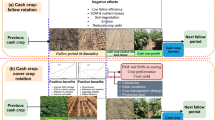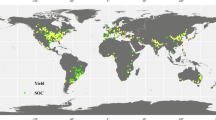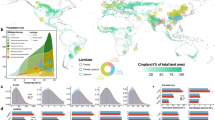Abstract
Cropland management practices that restore soil organic carbon (SOC) are increasingly presented as climate solutions that also enhance yields. But how often these benefits align at the farm level—the scale of farmers’ decision making—remains uncertain. We examined concurrent SOC and yield responses to cover cropping, including their direct connection, with a global meta-analysis. Cover cropping simultaneously increased yields and SOC in 59.7% of 434 paired observations. Increases in SOC directly increased crop yields in soils with initial SOC concentrations below 11.6 g kg−1; for example, a change from 5 g kg−1 to 6 g kg−1 increased yields by +2.4%. These yield benefits of SOC did not decline as nitrogen inputs increased or when legume cover crops were used, suggesting fertility inputs cannot substitute for SOC effects. Regardless of direct effects of SOC increases on yields, integrating legume cover crops into systems with simplified rotations or with nitrogen inputs < 157 kg ha−1 season−1 N led to the largest yield increases (up to +24.3%), with legumes also increasing SOC more than non-legumes (up to +1.5 g kg−1). By simultaneously increasing yields and SOC, cover cropping provides an opportunity to benefit both food security and climate, including via direct yield benefits from SOC increases on low carbon soils.




Similar content being viewed by others
Data availability
Data used in this meta-analysis are publicly available from the Dryad Digital Repository: https://doi.org/10.6078/D1013R. Global yield gap data in Fig. 4 were used from the Global Yield Gap Atlas8 (www.yieldgap.org).
Code availability
Code used in this meta-analysis are publicly available from the Dryad Digital Repository: https://doi.org/10.6078/D1013R.
References
Kibblewhite, M. G., Ritz, K. & Swift, M. J. Soil health in agricultural systems. Phil. Trans. R. Soc. B 363, 685–701 (2008).
Janzen, H. H., Janzen, D. W. & Gregorich, E. G. The ‘soil health’ metaphor: illuminating or illusory?. Soil Biol. Biochem. 159, 1–10 (2021).
Bronick, C. J. & Lal, R. Soil structure and management: a review. Geoderma 124, 3–22 (2005).
Philip Robertson, G. et al. Farming for ecosystem services: an ecological approach to production agriculture. BioScience 64, 404–415 (2014).
Oldfield, E. E., Bradford, M. A. & Wood, S. A. Global meta-analysis of the relationship between soil organic matter and crop yields. Soil 5, 15–32 (2019).
Manlay, R. J., Feller, C. & Swift, M. J. Historical evolution of soil organic matter concepts and their relationships with the fertility and sustainability of cropping systems. Agric. Ecosyst. Environ. 119, 217–233 (2007).
Lal, R. Enhancing crop yields in the developing countries through restoration of the soil organic carbon pool in agricultural lands. Land Degrad. Dev. 17, 197–209 (2006).
Sanderman, J., Hengl, T. & Fiske, G. J. Soil carbon debt of 12,000 years of human land use. Proc. Natl Acad. Sci. USA 114, 9575–9580 (2017).
Sherwood, S. & Uphoff, N. Soil health: research, practice and policy for a more regenerative agriculture. Appl. Soil Ecol. 15, 85–97 (2000).
Zomer, R. J., Bossio, D. A., Sommer, R. & Verchot, L. V. Global sequestration potential of increased organic carbon in cropland soils. Sci. Rep. 7, 15554 (2017).
McClelland, S. C., Paustian, K. & Schipanski, M. E. Management of cover crops in temperate climates influences soil organic carbon stocks: a meta-analysis. Ecol. Appl. 31, e02278 (2021).
Jian, J., Du, X., Reiter, M. S. & Stewart, R. D. A meta-analysis of global cropland soil carbon changes due to cover cropping. Soil Biol. Biochem. 143, 107735 (2020).
Poeplau, C. & Don, A. Carbon sequestration in agricultural soils via cultivation of cover crops—a meta-analysis. Agric. Ecosyst. Environ. 200, 33–41 (2015).
Bradford, M. A. et al. Soil carbon science for policy and practice. Nat. Sustain. 2, 1070–1072 (2019).
Esquivel, K. E. et al. The ‘sweet spot’ in the middle: why do mid-scale farms adopt diversification practices at higher rates? Front. Sustain. Food Syst. https://doi.org/10.3389/fsufs.2021.734088 (2021).
Marcillo, G. S. & Miguez, F. E. Corn yield response to winter cover crops: an updated meta-analysis. J. Soil Water Conserv. 72, 226–239 (2017).
Daryanto, S., Fu, B., Wang, L., Jacinthe, P.-A. & Zhao, W. Quantitative synthesis on the ecosystem services of cover crops. Earth Sci. Rev. 185, 357–373 (2018).
Garba, I. I., Bell, L. W. & Williams, A. Cover crop legacy impacts on soil water and nitrogen dynamics, and on subsequent crop yields in drylands: a meta-analysis. Agron. Sustain. Dev. 42, 34 (2022).
Abdalla, M. et al. A critical review of the impacts of cover crops on nitrogen leaching, net greenhouse gas balance and crop productivity. Glob. Change Biol. 25, 2530–2543 (2019).
Deines, J. M. et al. Recent cover crop adoption is associated with small maize and soybean yield losses in the United States. Glob. Change Biol. 29, 794–807 (2023).
Fageria, N. K., Baligar, V. C. & Bailey, B. A. Role of cover crops in improving soil and row crop productivity. Commun. Soil Sci. Plant Anal. 36, 2733–2757 (2005).
Chabbi, A. et al. Aligning agriculture and climate policy. Nat. Clim. Change 7, 307–309 (2017).
McDaniel, M. D., Tiemann, L. & Grandy, A. Does agricultural crop diversity enhance soil microbial biomass and organic matter dynamics? A meta-analysis. Ecol. Appl. 24, 560–570 (2014).
Lal, R. Beyond Copenhagen: mitigating climate change and achieving food security through soil carbon sequestration. Food Secur. 2, 169–177 (2010).
Lehmann, J. & Kleber, M. The contentious nature of soil organic matter. Nature 528, 60–68 (2015).
Oelofse, M. et al. Do soil organic carbon levels affect potential yields and nitrogen use efficiency? An analysis of winter wheat and spring barley field trials. Eur. J. Agron. 66, 62–73 (2015).
Schjønning, P. et al. in Advances in Agronomy Vol. 150 (ed. Sparks, D. L.) 35–79 (Elsevier, 2018).
Pan, G., Smith, P. & Pan, W. The role of soil organic matter in maintaining the productivity and yield stability of cereals in China. Agric. Ecosyst. Environ. 129, 344–348 (2009).
Oldfield, E. E., Wood, S. A. & Bradford, M. A. Direct effects of soil organic matter on productivity mirror those observed with organic amendments. Plant Soil 423, 363–373 (2018).
Oldfield, E. E., Wood, S. A. & Bradford, M. A. Direct evidence using a controlled greenhouse study for threshold effects of soil organic matter on crop growth. Ecol. Appl. 30, e02073 (2020).
Bai, X. et al. Responses of soil carbon sequestration to climate‐smart agriculture practices: a meta‐analysis. Glob. Change Biol. 25, 2591–2606 (2019).
Wood, S. A. & Blankinship, J. C. Making soil health science practical: guiding research for agronomic and environmental benefits. Soil Biol. Biochem. 172, 108776 (2022).
Janzen, H. H., van Groenigen, K. J., Powlson, D. S., Schwinghamer, T. & van Groenigen, J. W. Photosynthetic limits on carbon sequestration in croplands. Geoderma 416, 115810 (2022).
Schlesinger, W. H. Biogeochemical constraints on climate change mitigation through regenerative farming. Biogeochemistry 161, 9–17 (2022).
Kallenbach, C. M., Grandy, A. S., Frey, S. D. & Diefendorf, A. F. Microbial physiology and necromass regulate agricultural soil carbon accumulation. Soil Biol. Biochem. 91, 279–290 (2015).
Sokol, N. W. et al. Life and death in the soil microbiome: how ecological processes influence biogeochemistry. Nat. Rev. Microbiol. 20, 415–430 (2022).
Yang, J. & Zhang, J. Crop management techniques to enhance harvest index in rice. J. Exp. Bot. 61, 3177–3189 (2010).
Bowles, T. M. et al. Long-term evidence shows that crop-rotation diversification increases agricultural resilience to adverse growing conditions in North America. One Earth 2, 284–293 (2020).
Ponisio, L. C. et al. Diversification practices reduce organic to conventional yield gap. Proc. R. Soc. B 282, 20141396 (2015).
Hunter, M. C. et al. Cover crop mixture effects on maize, soybean, and wheat yield in rotation. Agric. Environ. Lett. 4, 180051 (2019).
Tribouillois, H., Constantin, J. & Justes, E. Cover crops mitigate direct greenhouse gases balance but reduce drainage under climate change scenarios in temperate climate with dry summers. Glob. Change Biol. 24, 2513–2529 (2018).
Basche, A. D., Miguez, F. E., Kaspar, T. C. & Castellano, M. J. Do cover crops increase or decrease nitrous oxide emissions? A meta-analysis. J. Soil Water Conserv. 69, 471–482 (2014).
Quemada, M., Lassaletta, L., Leip, A., Jones, A. & Lugato, E. Integrated management for sustainable cropping systems: looking beyond the greenhouse balance at the field scale. Glob. Change Biol. 26, 2584–2598 (2020).
Cotrufo, M. F., Wallenstein, M. D., Boot, C. M., Denef, K. & Paul, E. The Microbial Efficiency-Matrix Stabilization (MEMS) framework integrates plant litter decomposition with soil organic matter stabilization: do labile plant inputs form stable soil organic matter? Glob. Change Biol. 19, 988–95 (2013).
Jilling, A. et al. Minerals in the rhizosphere: overlooked mediators of soil nitrogen availability to plants and microbes. Biogeochemistry 139, 103–122 (2018).
Daly, A. B. et al. A holistic framework integrating plant–microbe–mineral regulation of soil bioavailable nitrogen. Biogeochemistry 154, 211–229 (2021).
Rose, T. J. et al. Prospects for summer cover crops in southern Australian semi-arid cropping systems. Agric. Syst. 200, 103415 (2022).
Kluger, D. M., Owen, A. B. & Lobell, D. B. Combining randomized field experiments with observational satellite data to assess the benefits of crop rotations on yields. Environ. Res. Lett. 17, 044066 (2022).
Slessarev, E. W. et al. Initial soil organic carbon stocks govern changes in soil carbon: reality or artifact? Glob. Change Biol. https://doi.org/10.1111/gcb.16491 (2022).
Pittelkow, C. M. et al. Productivity limits and potentials of the principles of conservation agriculture. Nature 517, 365–368 (2015).
Zhang, T., Chen, H. Y. H. & Ruan, H. Global negative effects of nitrogen deposition on soil microbes. ISME J. 12, 1817–1825 (2018).
Chen, C., Chen, H. Y. H., Chen, X. & Huang, Z. Meta-analysis shows positive effects of plant diversity on microbial biomass and respiration. Nat. Commun. 10, 1332 (2019).
Ma, Z. & Chen, H. Y. H. Effects of species diversity on fine root productivity in diverse ecosystems: a global meta-analysis: diversity effects on fine root productivity. Glob. Ecol. Biogeogr. 25, 1387–1396 (2016).
Akaike, H. Maximum likelihood identification of Gaussian autoregressive moving average models. Biometrika 60, 255–265 (1973).
Addicott, E. T., Fenichel, E. P., Bradford, M. A., Pinsky, M. L. & Wood, S. A. Toward an improved understanding of causation in the ecological sciences. Front. Ecol. Environ. 20, 474–480 (2022).
Bradford, M. A. et al. Quantifying microbial control of soil organic matter dynamics at macrosystem scales. Biogeochemistry 156, 19–40 (2021).
Hobbs, N. T. & Hilborn, R. Alternatives to statistical hypothesis testing in ecology: a guide to self teaching. Ecol. Appl. 16, 5–19 (2006).
Fox, J. & Monette, G. Generalized collinearity diagnostics. J. Am. Stat. Assoc. 87, 178–183 (1992).
Zuur, A. F., Ieno, E. N. & Elphick, C. S. A protocol for data exploration to avoid common statistical problems: data exploration. Methods Ecol. Evol. 1, 3–14 (2010).
Gelman, A. Scaling regression inputs by dividing by two standard deviations. Stat. Med. 27, 2865–2873 (2008).
R Core Team R: A Language and Environment for Statistical Computing (R Foundation for Statistical Computing, 2022).
Bates, D., Mächler, M., Bolker, B. & Walker, S. Fitting linear mixed-effects models using lme4. J. Stat. Softw. 67, 1494–1502 (2015).
Lenth, R. V. et al. emmeans: Estimated marginal means, aka least-squares means. R package version 1.8.5 https://CRAN.R-project.org/package=emmeans (2022).
Dunn, O. J. Multiple comparisons among means. J. Am. Stat. Assoc. 56, 52–64 (1961).
Kenward, M. G. & Roger, J. H. Small sample inference for fixed effects from restricted maximum likelihood. Biometrics 53, 983–997 (1997).
Potapov, P. et al. Global maps of cropland extent and change show accelerated cropland expansion in the twenty-first century. Nat. Food 3, 19–28 (2021).
Hengl, T. et al. SoilGrids250m: global gridded soil information based on machine learning. PLoS ONE 12, e0169748 (2017).
Acknowledgements
We thank the Organic Center for providing funding to T.M.B. and I.V. for this project. T.M.B. also acknowledges USDA NIFA Agriculture and Food Research initiative (grant 2017- 67013-26254). A portion of this work was performed under the auspices of the US Department of Energy by Lawrence Livermore National Laboratory under contract DE-AC52-07NA27344 (A.C.M.).
Author information
Authors and Affiliations
Contributions
I.V., T.M.B. and L.P. conceived the ideas and designed methodology; I.V. and G.D.L.C. collected the data; I.V., A.G., K.E., and A.C.M. analysed the data; I.V. and T.M.B. led the writing of the manuscript. All authors contributed critically to the drafts and gave final approval for publication.
Corresponding author
Ethics declarations
Competing interests
The authors declare no competing interests.
Peer review
Peer review information
Nature Sustainability thanks Gina Garland and the other, anonymous, reviewer(s) for their contribution to the peer review of this work.
Additional information
Publisher’s note Springer Nature remains neutral with regard to jurisdictional claims in published maps and institutional affiliations.
Supplementary information
Supplementary Information
Supplementary Figs. 1–9, Tables 1–8 and Methods.
Rights and permissions
Springer Nature or its licensor (e.g. a society or other partner) holds exclusive rights to this article under a publishing agreement with the author(s) or other rightsholder(s); author self-archiving of the accepted manuscript version of this article is solely governed by the terms of such publishing agreement and applicable law.
About this article
Cite this article
Vendig, I., Guzman, A., De La Cerda, G. et al. Quantifying direct yield benefits of soil carbon increases from cover cropping. Nat Sustain 6, 1125–1134 (2023). https://doi.org/10.1038/s41893-023-01131-7
Received:
Accepted:
Published:
Issue Date:
DOI: https://doi.org/10.1038/s41893-023-01131-7
- Springer Nature Limited





